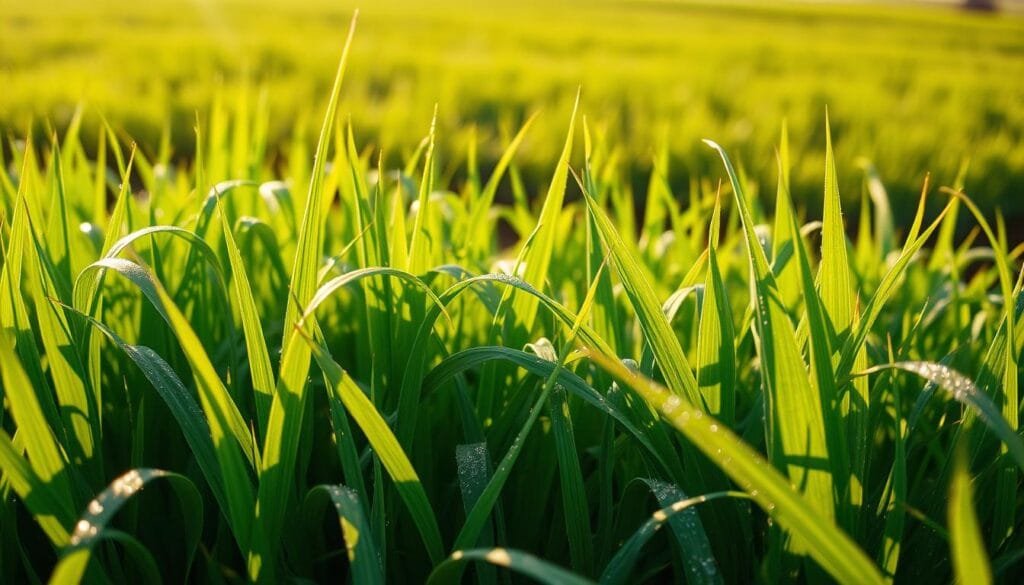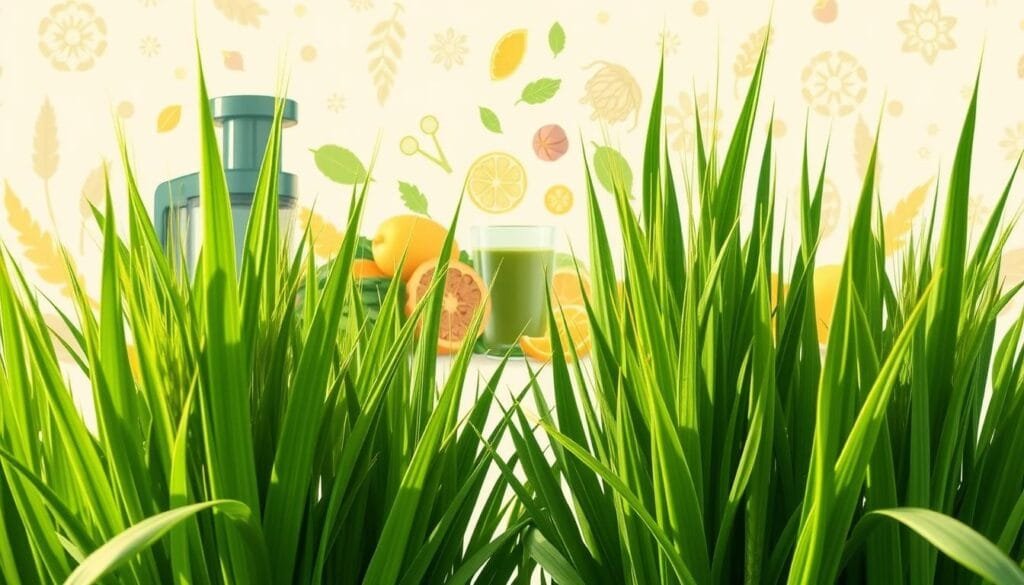Currently Empty: RM0.00
Did you know that wheatgrass was used by Ancient Egyptians over 5,000 years ago for its health benefits? Today, it remains a popular superfood, alongside its cousin, barley grass. Both are packed with essential nutrients and have been celebrated for their detoxifying and energizing properties.
At Wellness Concept, we specialize in comparing nutrient-dense superfoods like these. Both wheatgrass and barley grass are gluten-free, as confirmed by rigorous lab testing. They offer unique benefits, from high protein content to rich fiber levels and powerful antioxidants like SOD.
Need personalized advice? Reach out via WhatsApp at +60123822655. Our team is available Mon-Fri 9:30am-6:30pm and Sat-Sun 10am-5pm. Discover how these ancient superfoods can support your modern health goals.
Key Takeaways
- Wheatgrass and barley grass are nutrient-dense superfoods with ancient origins.
- Both are gluten-free, making them suitable for many diets.
- They are rich in protein, fiber, and antioxidants like SOD.
- Wellness Concept offers expert comparisons and personalized advice.
- Contact us via WhatsApp +60123822655 for more information.
Introduction to Wheat Grass and Barley Grass
Ancient civilizations valued these nutrient-packed greens for their health benefits. Wheatgrass, the immature shoots of Triticum Aestivum, and barley grass, the young leaves of Hordeum Vulgare, are harvested before grain formation. This timing locks in peak nutrition.
Despite their names, both are gluten-free. Rheal’s lab tests confirm this, and co-founder Charlotte, a Coeliac, safely uses them. Their gluten-free status makes them versatile for modern diets.
Historically, these greens trace back over 1,000 years. Ancient Egyptians prized them for vitality. Today, they’re available as fresh juices, powders, or capsules. Modern extraction methods preserve their enzymes and antioxidants.
Both belong to the Poaceae family, sharing traits like high chlorophyll content. Yet, their unique profiles cater to different health goals. Whether blended into smoothies or taken as supplements, they’re a powerful addition to wellness routines.
Similarities Between Wheat Grass and Barley Grass
When it comes to nutrient-packed greens, wheatgrass and barley grass have much in common. Both are celebrated for their dense profiles of vitamins and minerals, making them essential for a balanced diet. They also share unique properties that support overall health and wellness.

Nutrient Density
Both superfoods are rich in essential nutrients. They contain over 13 vitamins and minerals, including vitamins A, C, E, K, calcium, iron, and magnesium. This makes them a powerhouse for boosting energy and supporting the body’s functions. Their negative PRAL scores (Barley -38, Wheat -63) also highlight their alkalising effects, which help balance the body’s pH levels.
Chlorophyll Content
High chlorophyll levels are another shared trait. This natural pigment not only gives them their vibrant green color but also supports oxygen transport and wound healing. Studies show that chlorophyll can reduce inflammatory cytokines like TNF-α and IL-6, making it a key player in anti-inflammatory processes.
Alkalising Properties
Both greens are known for their strong alkalising properties. Compared to kale (-8) and broccoli (-3), their PRAL scores are significantly lower, making them superior choices for detoxification. Products like Morlife Alkalising Greens® take this a step further, with PRAL scores ranging from -127 to -137. This enhanced formula offers a premium option for those seeking maximum benefits.
Additionally, they both contain shared antioxidant enzymes like superoxide dismutase (SOD), which combat oxidative stress. Their blood-building properties, through globin production, and energy-boosting effects from nutrient synergy further cement their status as must-have superfoods.
Differences Between Wheat Grass and Barley Grass
While both superfoods share similarities, their unique differences make them stand out in distinct ways. Understanding these variations can help you choose the one that best fits your health goals.
Protein and Carbohydrate Content
One of the key differences lies in their protein content. Wheat grass contains 28g of protein per 100g, making it an excellent choice for muscle builders. Barley grass, on the other hand, offers 22.1g of protein per 100g, which is still substantial but slightly lower.
When it comes to carbohydrate content, barley grass has 8g per 100g, while wheat grass contains only 4.9g. This makes wheat grass a better option for those on low-carb diets.
Dietary Fiber and Fat Content
Barley grass takes the lead in dietary fiber, with 56.5g per 100g compared to wheat grass’s 34g. This higher fiber content supports digestive health and can be beneficial for those with specific dietary needs.
In terms of fat content, barley grass has 4.3g per 100g, while wheat grass contains 5.8g. Both are low in fat, but the slight difference may influence your choice depending on your dietary preferences.
Taste and SOD Content
Barley grass is known for its milder taste, making it a favorite for those who are sensitive to strong flavors. Wheat grass, on the other hand, has a more robust taste that some may find intense.
Another notable difference is in their SOD content. Wheat grass boasts 303,000 units of superoxide dismutase (SOD) per 100g, compared to barley grass’s 146,000 units. SOD is a powerful antioxidant that plays a crucial role in cellular protection.
| Nutrient | Wheat Grass | Barley Grass |
|---|---|---|
| Protein (per 100g) | 28g | 22.1g |
| Carbohydrate Content (per 100g) | 4.9g | 8g |
| Dietary Fiber (per 100g) | 34g | 56.5g |
| Fat Content (per 100g) | 5.8g | 4.3g |
| SOD Content (per 100g) | 303,000 units | 146,000 units |
For more detailed comparisons, check out this comprehensive guide.
Health Benefits of Wheat Grass and Barley Grass
Both wheatgrass and barley grass offer a range of health benefits that can transform your wellness routine. From supporting detoxification to enhancing brain function, these superfoods are packed with nutrients that cater to various aspects of health.

Detoxification and Digestive Health
One of the standout benefits of these greens is their ability to support detoxification. Chlorophyll, a key component, aids in liver detox by promoting the production of glutathione, a powerful antioxidant. Barley grass, with its 3g of fiber per tablespoon, helps address the UK fiber deficit, promoting healthy digestion.
Prebiotic fiber in both greens feeds gut microbiota, enhancing digestive health. This makes them an excellent choice for those looking to improve their gut function naturally.
Brain Health and Energy Levels
Wheatgrass is known for its neuroprotective effects, which can enhance memory and cognitive function. Barley grass contains GABA, an amino acid that helps reduce stress and anxiety, supporting overall brain health.
Iron levels in these greens improve oxygen circulation, boosting energy levels. Their alkalizing properties also reduce muscle fatigue, making them ideal for active individuals.
Skin and Bone Health
Chlorophyll’s skin regeneration properties make these greens a natural choice for improving skin health. Wheatgrass accelerates wound healing, while barley grass supports collagen production.
Calcium and magnesium in both greens contribute to bone density, making them beneficial for long-term bone health. Rheal’s Clean Greens blend has shown impressive results in enhancing these benefits.
| Benefit | Wheat Grass | Barley Grass |
|---|---|---|
| Detoxification | High chlorophyll content | 3g fiber/tbsp |
| Brain Health | Neuroprotective effects | GABA for stress reduction |
| Skin Health | Wound healing acceleration | Collagen support |
| Bone Health | Calcium and magnesium | Calcium and magnesium |
How to Use Wheat Grass and Barley Grass
Looking to incorporate nutrient-rich greens into your daily routine? These superfoods are incredibly versatile and can be enjoyed in various forms. From fresh juices to convenient powders, there’s a method to suit every lifestyle.
Juices and Smoothies
Starting your day with a juice or smoothie is a great way to boost your energy. Freshly extracted juices retain the natural enzymes and nutrients, making them a quick and effective option. For a creamy texture, blend these greens into smoothies with fruits like bananas or berries.
Powders and Supplements
For those on the go, powders and supplements offer a convenient alternative. Rheal’s Clean Greens, with just 5 ingredients, stands out against competitors with 40+ ingredients. These powders can be mixed into water, smoothies, or even baked goods for an easy nutrient boost.
| Powder Type | Benefits |
|---|---|
| Raw Extracts | Retains natural enzymes and nutrients |
| Juice Extracts | Concentrated nutrients for quick absorption |
Recipes and Combinations
Experiment with recipes to make these greens a staple in your diet. Try a Super Greens Pesto by blending Rheal’s Clean Greens with basil, garlic, olive oil, and nuts. For a protein-packed option, combine them with Spirulina and Chlorella in a green hummus.
Need personalized advice? Reach out to Wellness Concept via WhatsApp at +60123822655. Our team is available Mon-Fri 9:30am-6:30pm and Sat-Sun 10am-5pm. Let us help you find the best products and combinations for your needs.
Conclusion
For those seeking a natural boost to their wellness routine, these nutrient-rich greens are a game-changer. Both offer unique health benefits, making them complementary choices for a balanced diet. Alternating between them can provide varied nutrients and maximize their advantages.
Combining these greens with other green vegetables can enhance their effects, creating a powerhouse of nutrition. Their high SOD content makes them ideal for active lifestyles, supporting energy and recovery.
At Wellness Concept, expert guidance is just a message away. Reach out via WhatsApp at +60123822655 for personalized advice. The team is available Mon-Fri 9:30am-6:30pm and Sat-Sun 10am-5pm. Make these greens a part of your day and experience their transformative benefits.
FAQ
What are the main differences between wheatgrass and barley grass?
Wheatgrass has a stronger, slightly bitter taste, while barley grass is milder and sweeter. Barley grass contains more fiber and fat, whereas wheatgrass is higher in protein. Both are nutrient-dense but differ in their superoxide dismutase (SOD) content, with barley grass leading in this antioxidant.
Which has more chlorophyll—wheatgrass or barley grass?
Both are excellent sources of chlorophyll, but barley grass typically has a slightly higher concentration. This green pigment supports detoxification and helps maintain healthy blood oxygen levels.
Can wheatgrass and barley grass help with digestion?
Yes! Both contain enzymes and fiber that aid digestion. Barley grass has more dietary fiber, which promotes gut health, while wheatgrass supports liver detoxification, improving overall digestive function.
Are there any side effects from consuming these superfoods?
Some people may experience mild nausea or headaches when first introducing them into their diet. Starting with small doses, like a teaspoon of powder or a shot of juice, helps the body adjust.
How can I incorporate wheatgrass and barley grass into my meals?
Both can be blended into smoothies, mixed into juices, or taken as powdered supplements. Barley grass works well in teas, while wheatgrass is often consumed as fresh shots for a quick nutrient boost.
Which is better for skin health—wheatgrass or barley grass?
Both support skin health due to their antioxidants and vitamins. Wheatgrass helps with detoxification, reducing breakouts, while barley grass’s high SOD content fights oxidative stress, promoting a youthful glow.
Do wheatgrass and barley grass provide energy benefits?
Absolutely! Their rich nutrient profiles, including B vitamins and iron, help combat fatigue. Many users report improved energy levels and mental clarity when consumed regularly.



